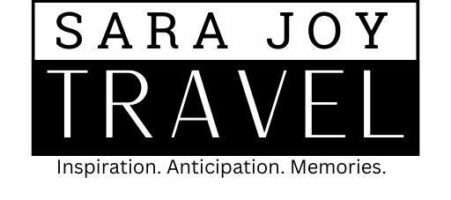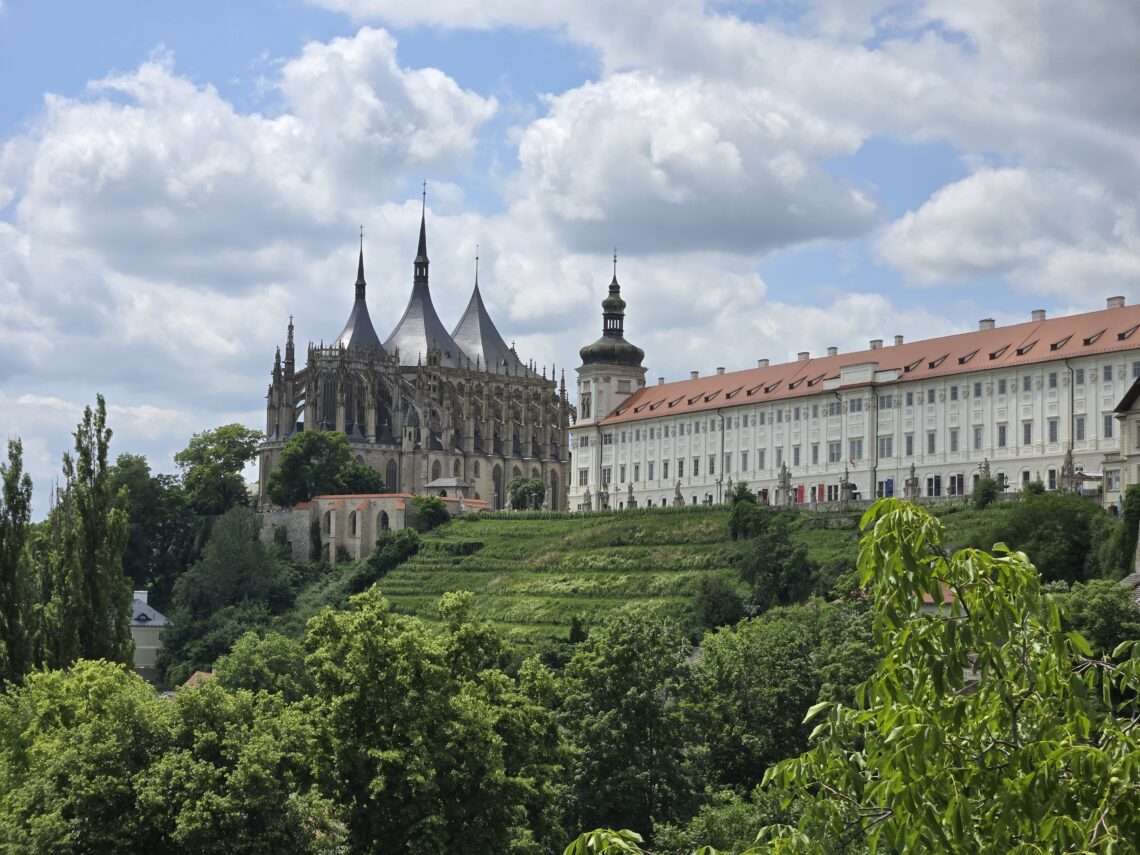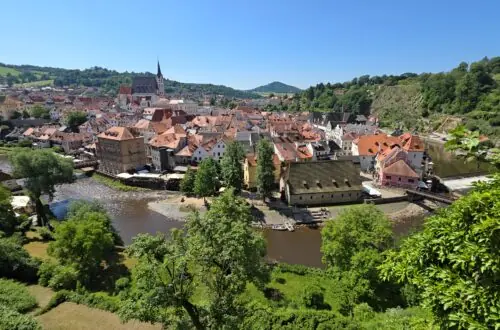On our recent trip to Prague, we detoured to Kutná Hora—a UNESCO-listed town whose historic center and churches rose on the wealth of 13th-century silver. By the 14th century it was a royal city, and it still shows. My son had it on his “must-see” list, and after a little research I was convinced. We went for the Bone Church, but the true showstopper was the Gothic St. Barbara’s Cathedral—I’d return just to see it again. If you’re in Prague, Kutná Hora is a day trip you shouldn’t skip.
Prague to Kutna Hora
We took the train from Prague to Kutná Hora—easy, inexpensive, and about 50 minutes once we were moving. We started later than planned, waited about half an hour for a direct train, and then hit a short delay, so the morning didn’t go perfectly. But buying tickets at the station was simple, and the price made the train the best option for us.
There are 3 train stations in Kutna Hora
While I do recommend the train, our trip didn’t unfold as planned. I bought tickets to Kutná Hora Nádraží, where we got off—only to realize the same train continued on to Kutná Hora–Sedlec (the stop for the Bone Church). Somewhere in the shuffle we actually stepped off at Kutná Hora město instead. That put us closer to St. Barbara’s Cathedral than the Ossuary, so we pivoted and started there.
Kutná Hora–Sedlec → closest to the Sedlec Ossuary (Bone Church)
Kutná Hora město → above the historic center (good for St. Barbara’s)
Kutná Hora hlavní nádraží / Nádraží → mainline station outside town; transfer point to the local train
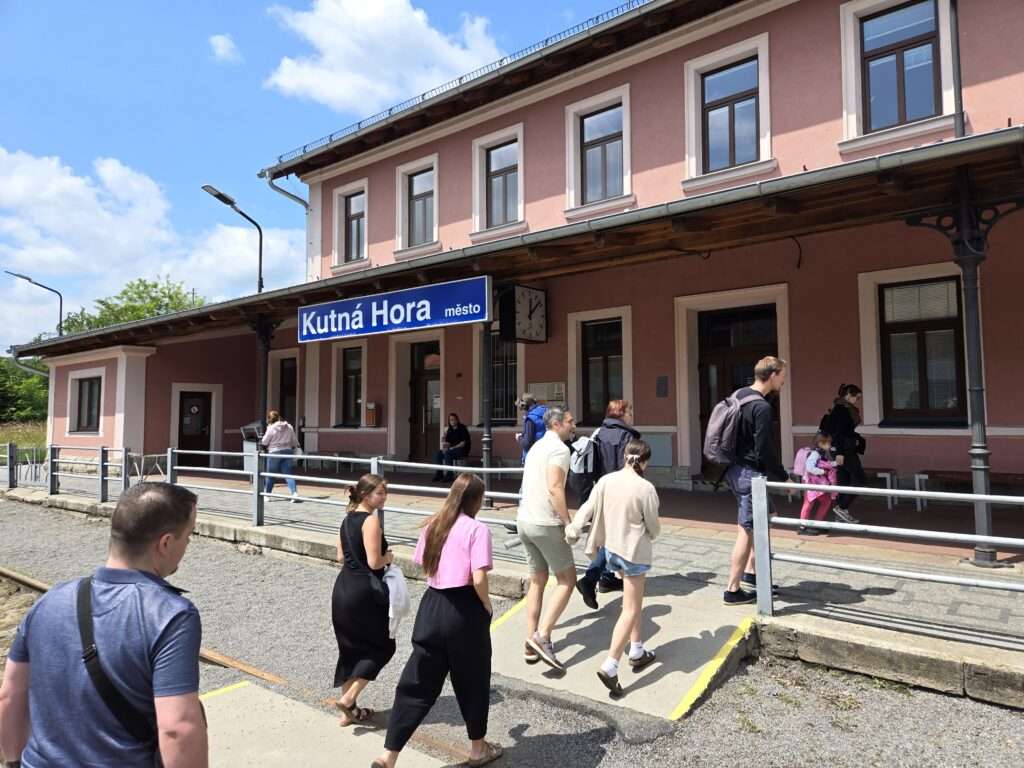
Photo above: This is what the Kutna Hora-Mesto station looks like when you arrive. Again, it brings you closest to St. Barbara’s Church. You can easily walk there from here.
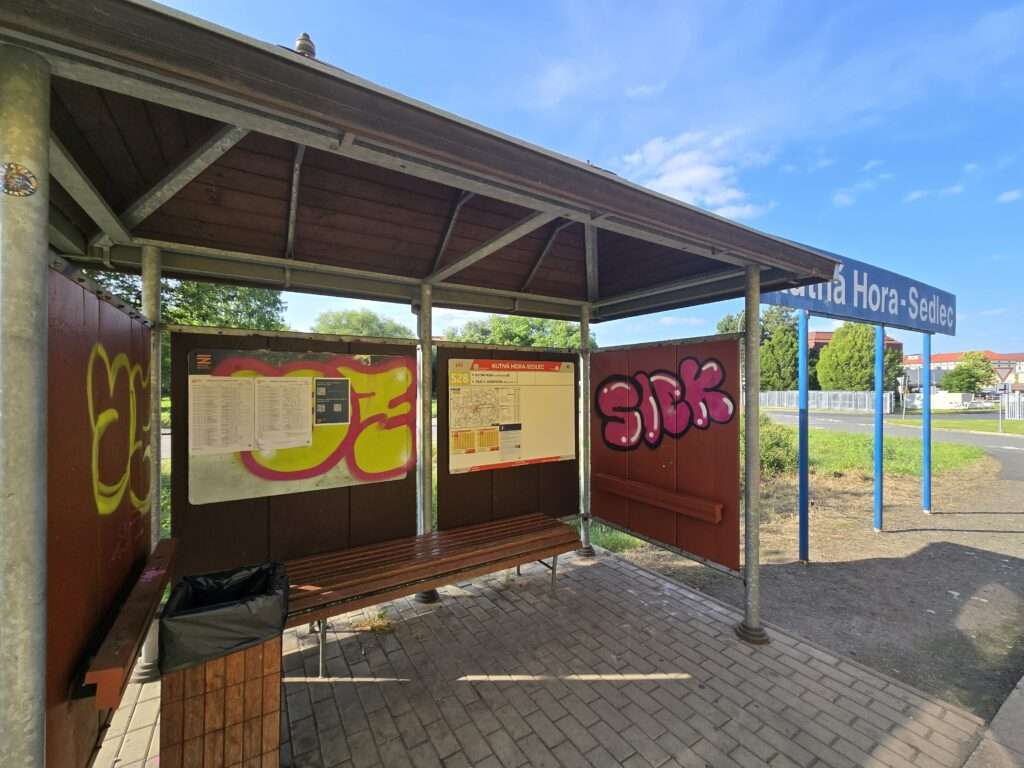
Photo above: The Kutna Hora-Sedlec train stop looks more like a bus stop – no wonder we missed it. We could barely find it even when we tried, using Google maps. This station is closest to the Bone Church.
The train from Prague to Kutna Hora was clean and efficient. We didn’t need reserved seats. The train really wasn’t all that full when we traveled. In general, while there are tourists here, this seemed to be a bit of a hidden gem off the main tourist circuit.
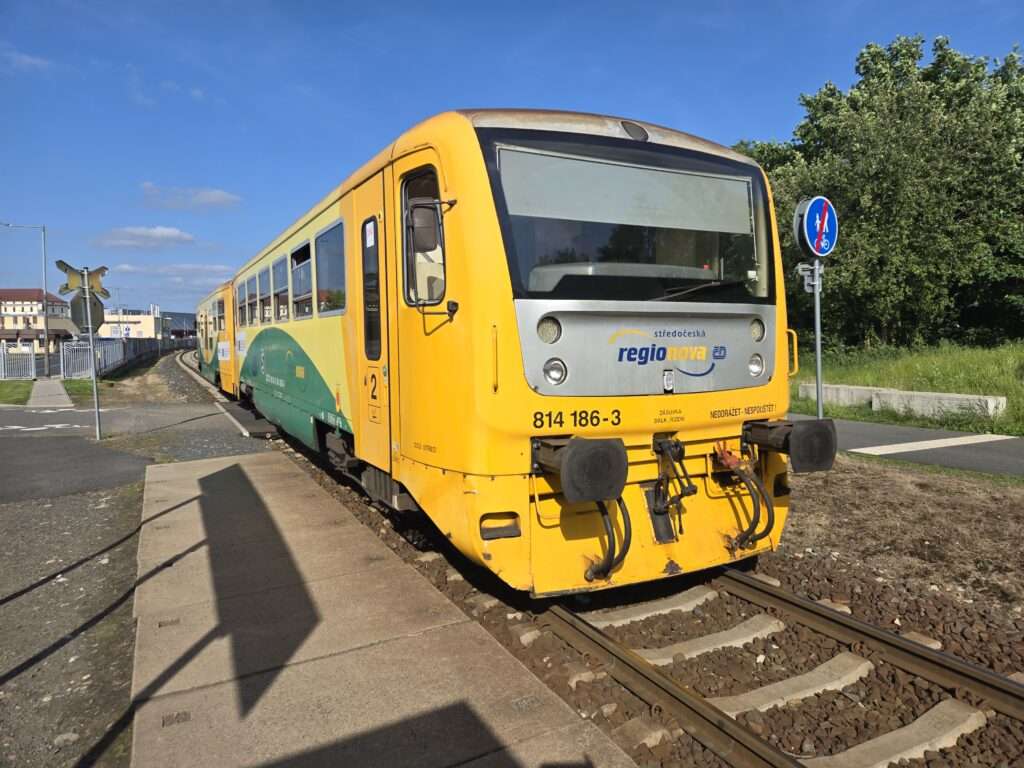
Photo above: The exterior of the train running between Prague and Kutna Hora.
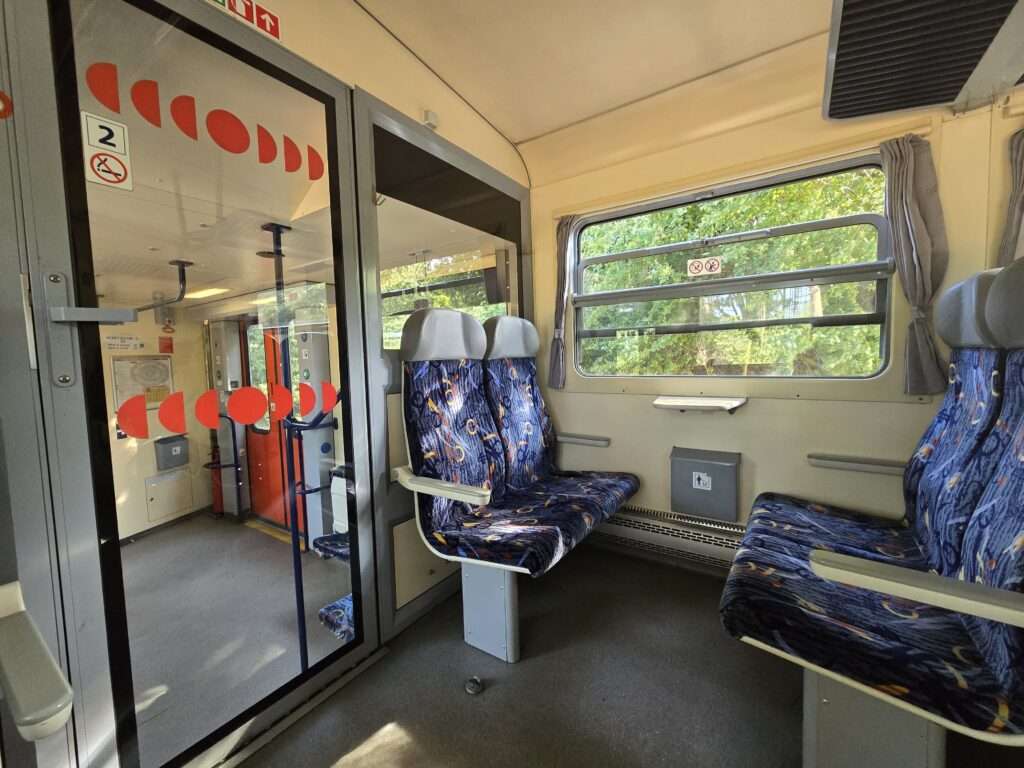
Photo above: The interior of the train running between Prague and Kutna Hora. Always clean.
Old Town Kutna Hora
Kutná Hora feels a little magical. Prosperous since the silver boom of the late 13th century, it still radiates a welcoming opulence that pulls you into another time. We arrived behind schedule, but once I started walking those streets I stopped caring. I wanted to linger—soak up the lanes, the little shops, the façades, the views. It was utterly amazing. I already knew this place was special, and I hadn’t even seen the headliners yet.
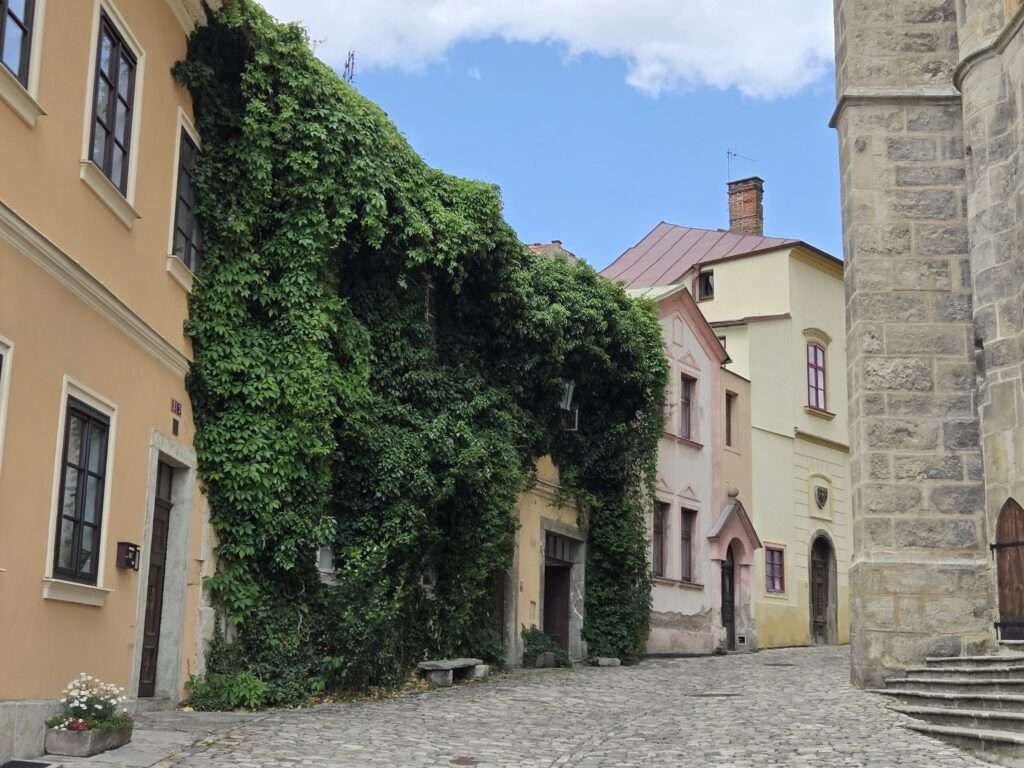
And it wasn’t just me. My kids soaked the place in too. They could feel this was a place that would come with us, when we left at the end of the day.
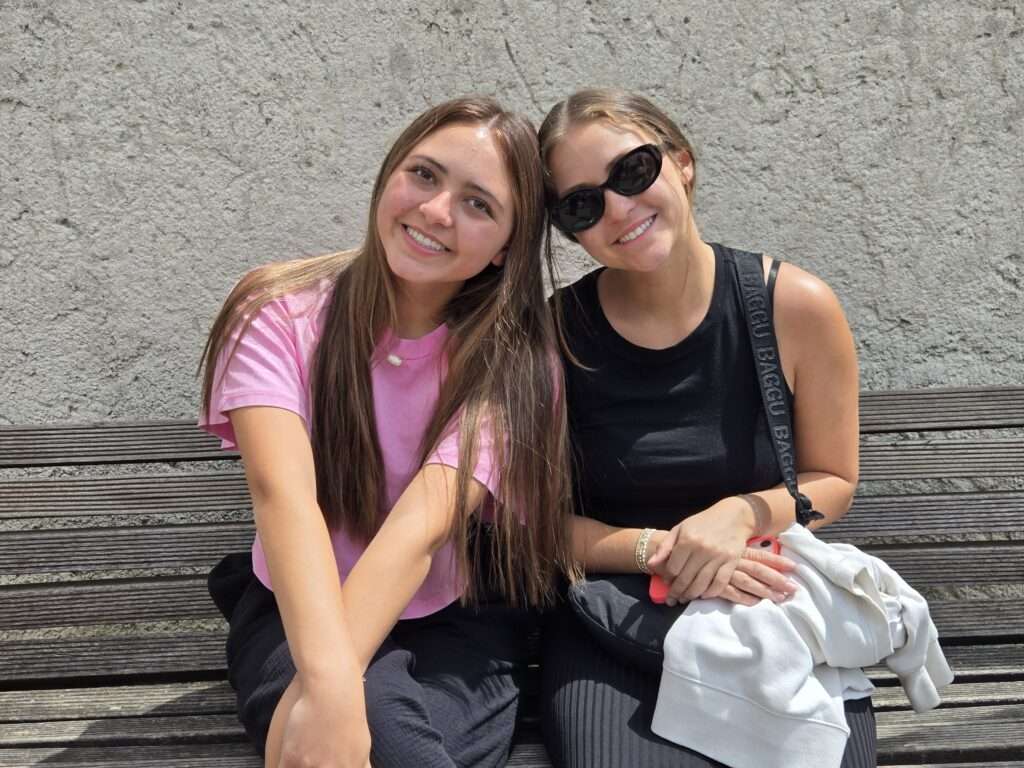
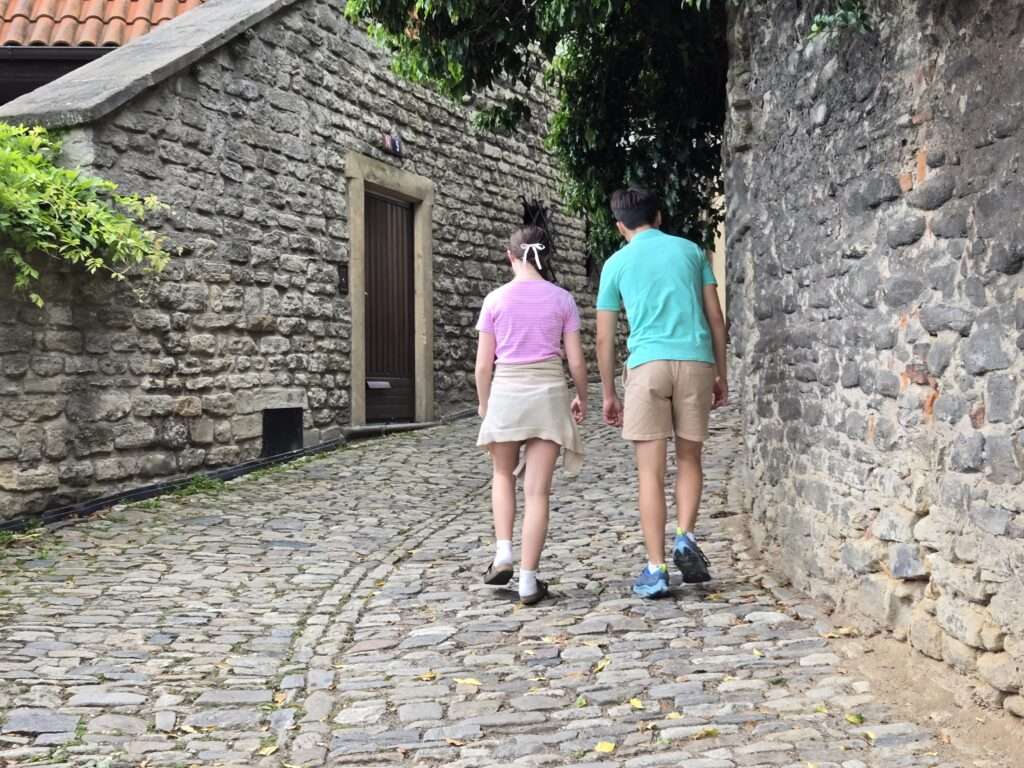
It's a Day Trip, with So Much to See!!!
So I am sharing some photos here, of random things we discovered in our walk. It seemed every few minutes we came upon something I deemed worthy of another photo. There was so much care and attention to detail in this town, and i wanted to notice it all. I’m sure I failed, but I tried.
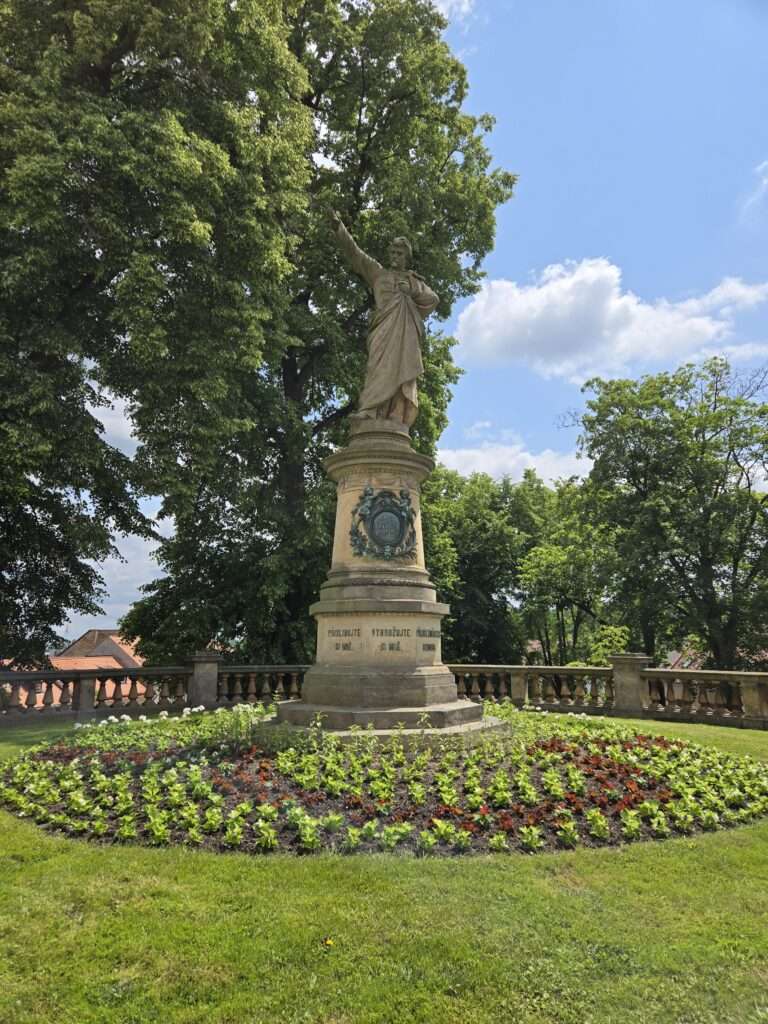
Photo above: A sculpture of Karel Havlíček Borovský, a famous Czech politician, journalist, writer, and poet from the 19th century.
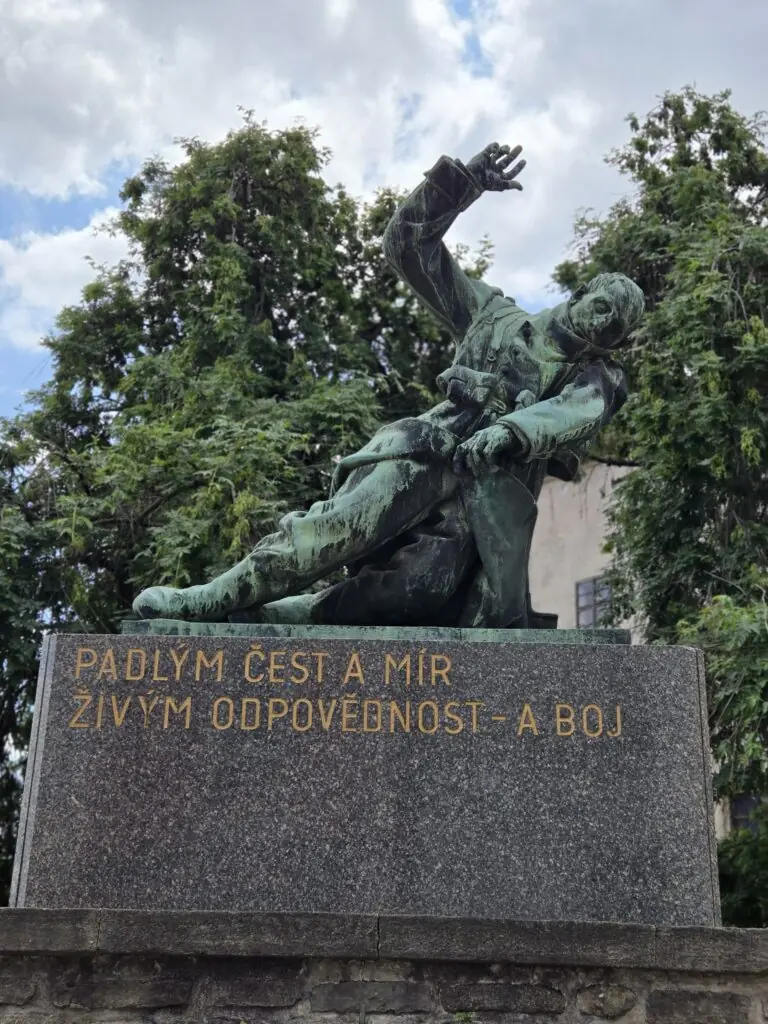
Photo above: WWI monument from 1933-1934 by Karel Dvořák and Pavel Janák. Shows a wounded soldier falling on his left side.
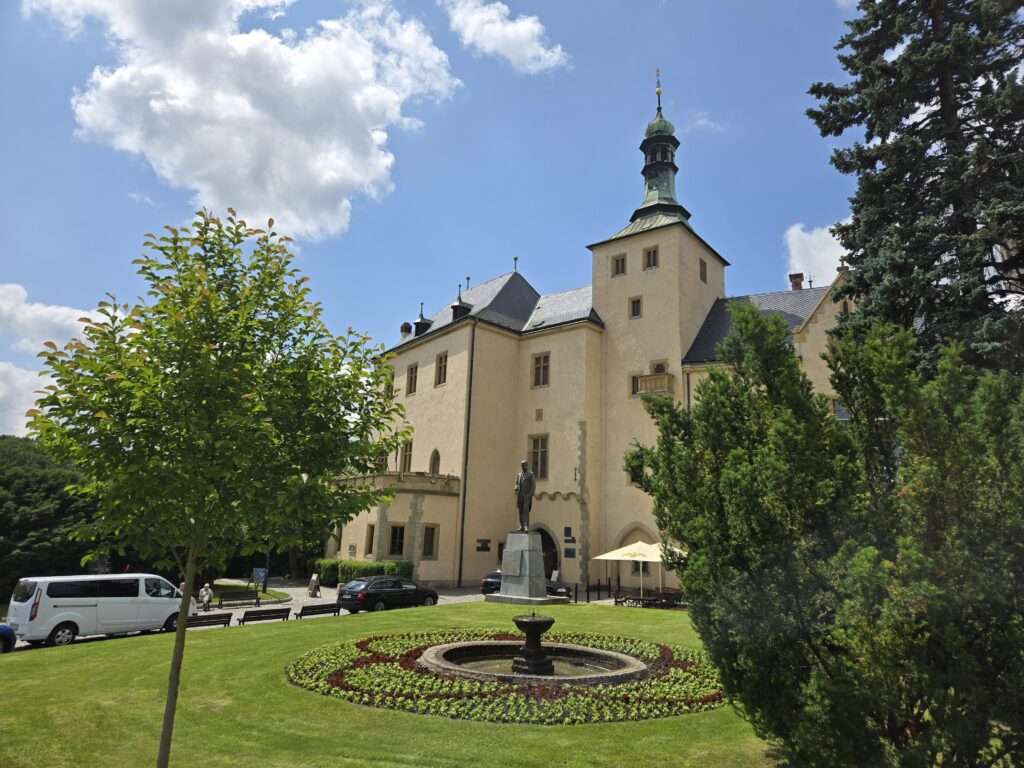
Photo above: We walked by the Italian Court. I had originally planned to visit, but this was one site we had to skip due to our late arrival.
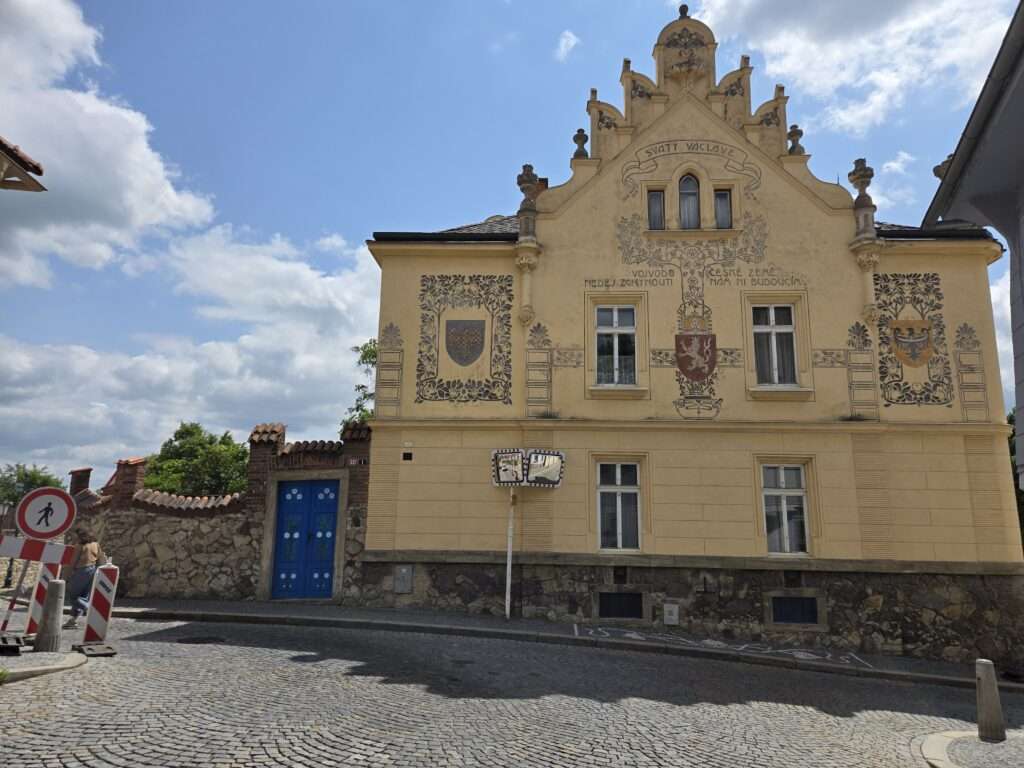
Photo above: I wasn’t sure waht this building was but it was beautiful.
Stumbling Upon One of My Favorite Places - St. Barbara's Church
In search of the Bone Church really, we ended up in this town, and discovering this amazing cathedral. If you read my blog, you know I have seen some pretty impressive churches and cathedrals, but wow, this one was unlike any other. It was so striking. It commanded my attention. It drew me near. I wanted to see it; I wanted to know it. I knew it was special from the first glimpse. There was never a doubt that this would be “just another cathedral.”
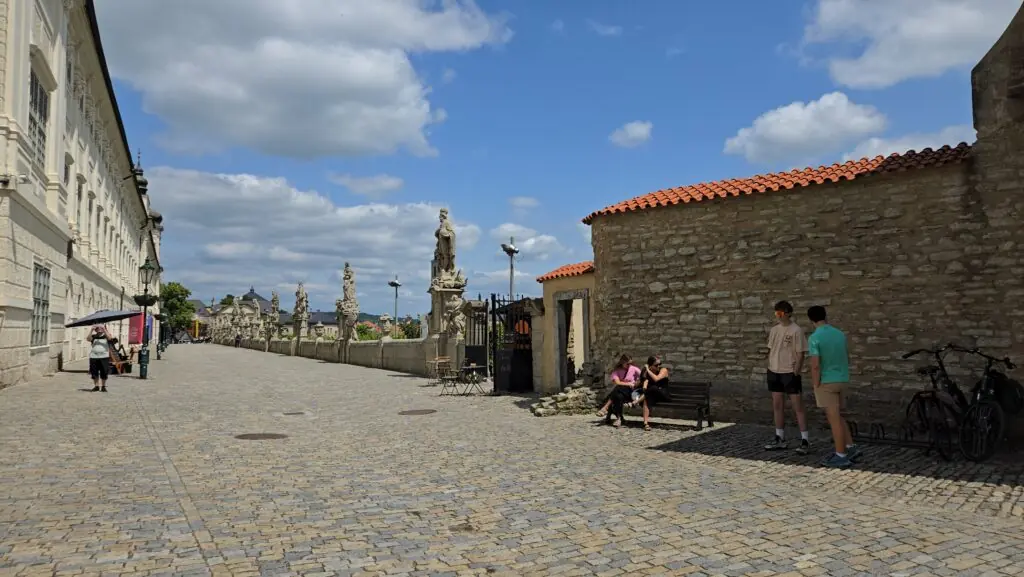
Photo above: The views slowed us down long before the cathedral did. Then came Barborská Street, Kutná Hora’s “Charles Bridge,” with 13 statues marching along the edge—the second is St. Barbara, miners’ patron.
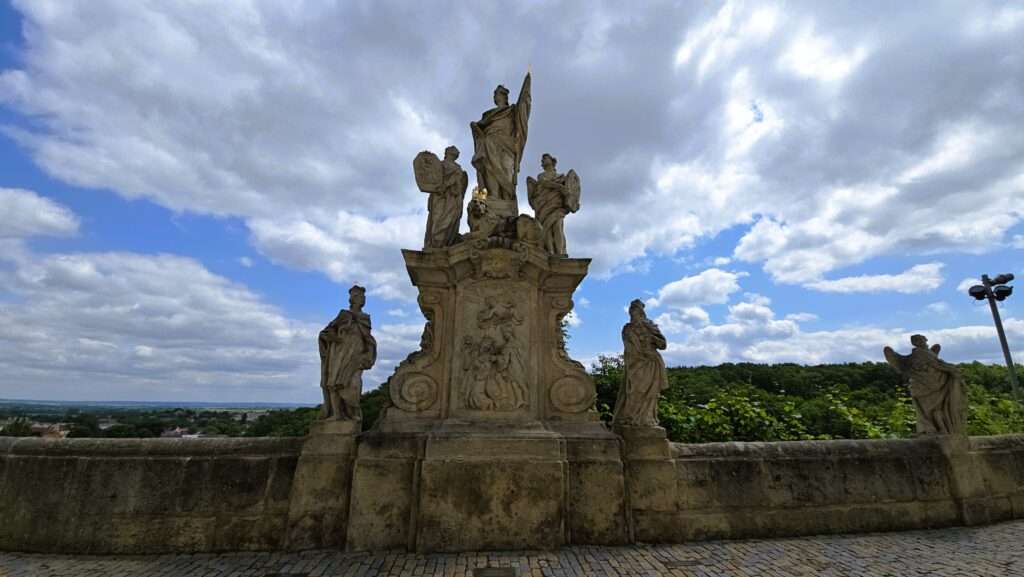
Photo above: Unlike Prague, this area was not overcrowded and we could admire the statues up close and in detail. They stood tall saying so much, with the world seemingly its backdrop. I couldn’t believe I hadn’t read about this beforehand.
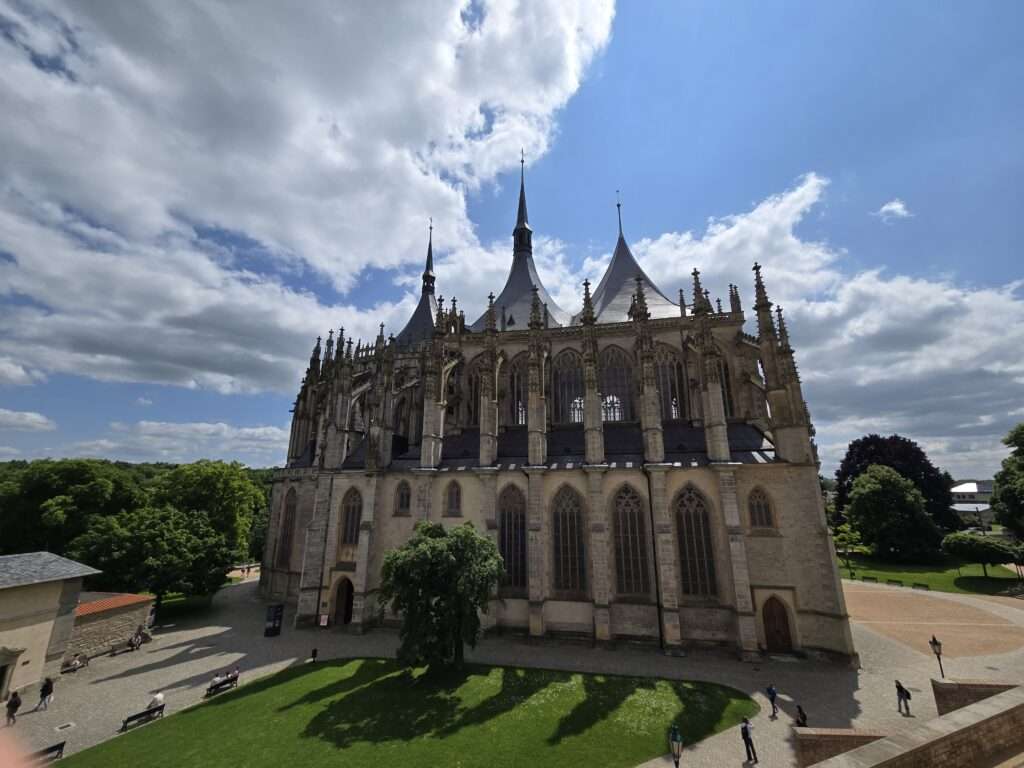
Photo above: And then there she was, so beautiful that she will get her own post soon. I could study her all day, and still not be bored.
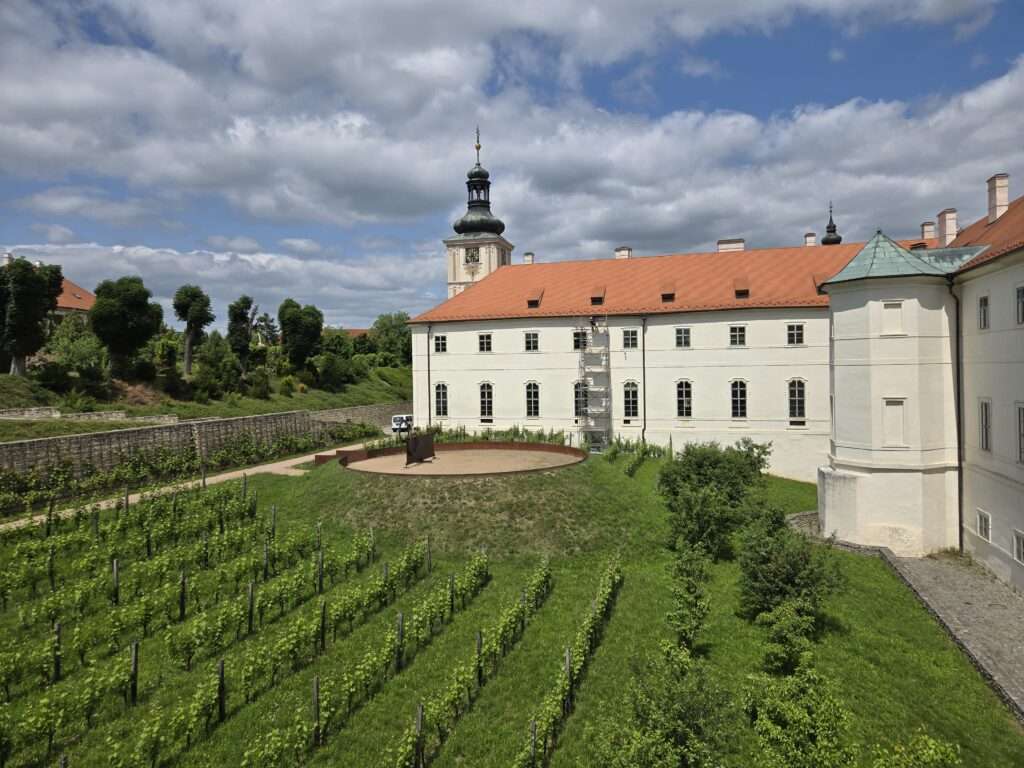
Photo above: Across from St. Barbara’s Church is the Jesuit College. We only had time to admire the exterior and capture some great photos of the cathedral from its terrace.
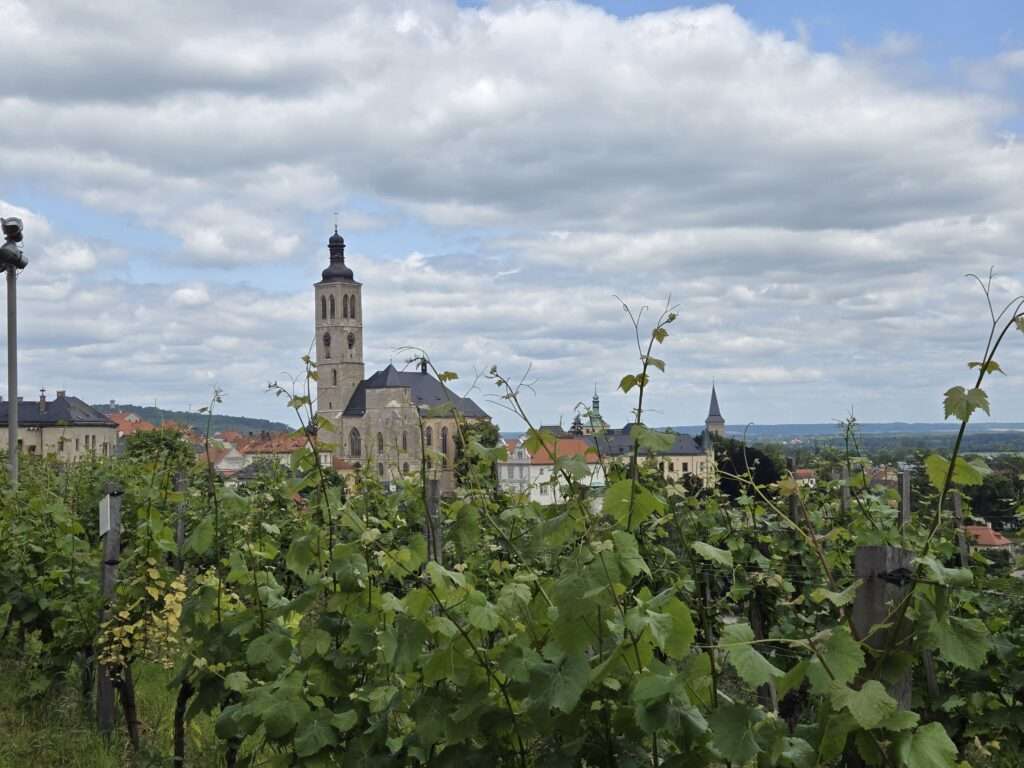
Lunch in Kutna Hora at Restaurace Dacicky
We were lucky enough to eat at this historical restaurant in Kutna Hora. We made lunch reservations in advance, but missed them, and yet still lucked out with a nice table in the garden. Restaurace Dacicky was the perfect place for a meal while visiting this historic town and its sites. It probably is a bit touristy, but they had the local Kutna Hora beer on tap and this didn’t seem to cater specifically to Americans or such, so it didn’t feel too touristy to me. After all, even in the 13th century, this town was catering to visitors.
What to order: roast duck with red cabbage & dumplings, or wild-boar goulash; wash down with Kutna Hora lager on tap. Meals are around 230-400 CZK. See the full menu here.
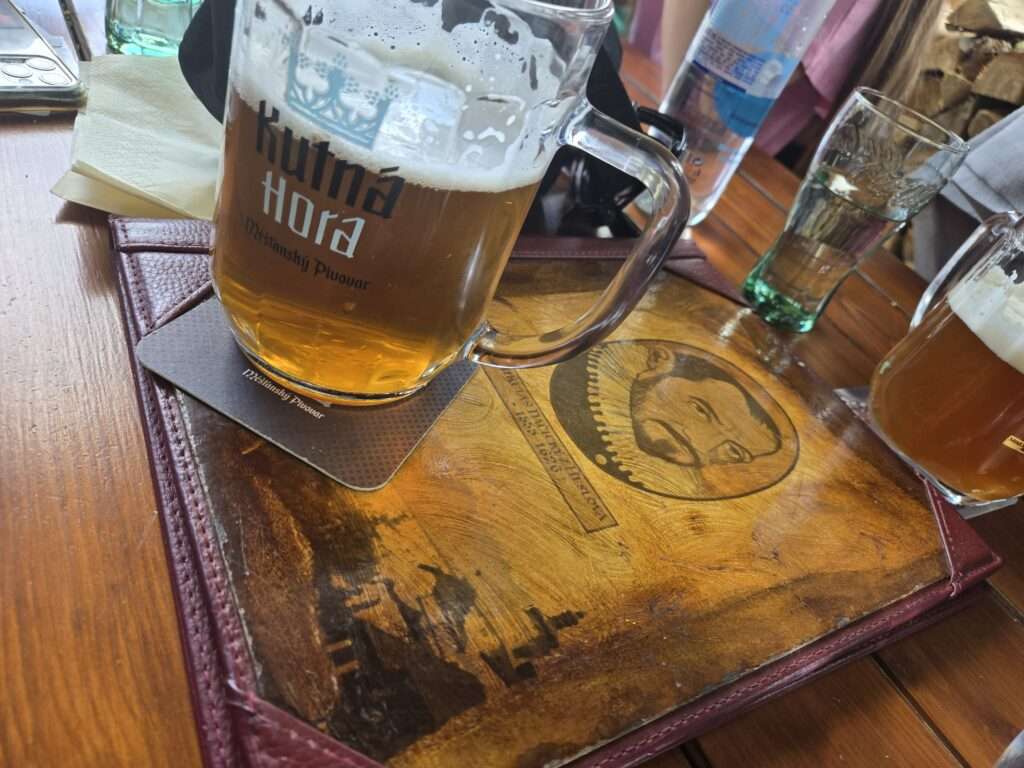
The restaurant dates back the 19th century, but the food is fresh and tasty. Gary got a little cold in the shade and they even had blankets to keep him warm. While you can’t see it in the photos, the garden seating area also had a small playground for children.

Photo above: We arrived in between mealtimes and had our pick of tables!
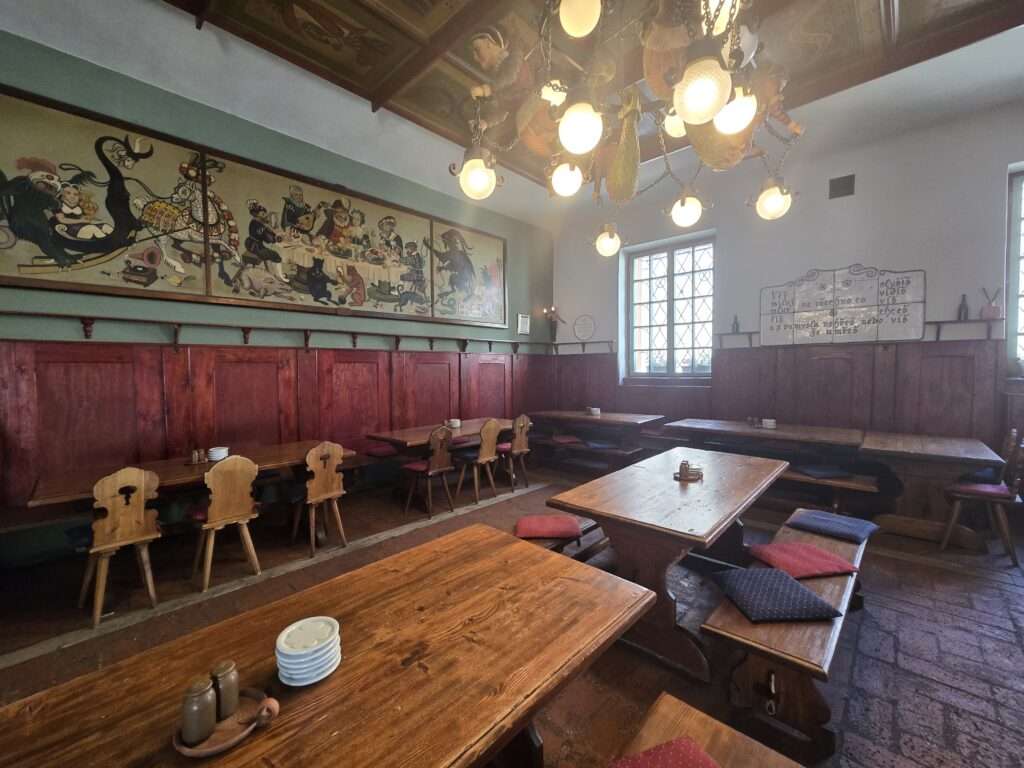
Photo above: And, it was easy to snap some photos of the inside, as it was pretty empty at that moment too.
The City Bus from St. Barbara's Church to the Bone Chapel
After drinks and food, we set off for the Bone Chapel. We wound through the historic center looking for the bus that connects the old town with Sedlec. I didn’t really want to leave—I could’ve lingered for hours—but we’d come specifically for the Bone Church, so we kept moving. Google Maps led us to the stop, and we hopped bus 801 or 802 (either works). It was about 20 minutes, and we were very glad we didn’t walk.
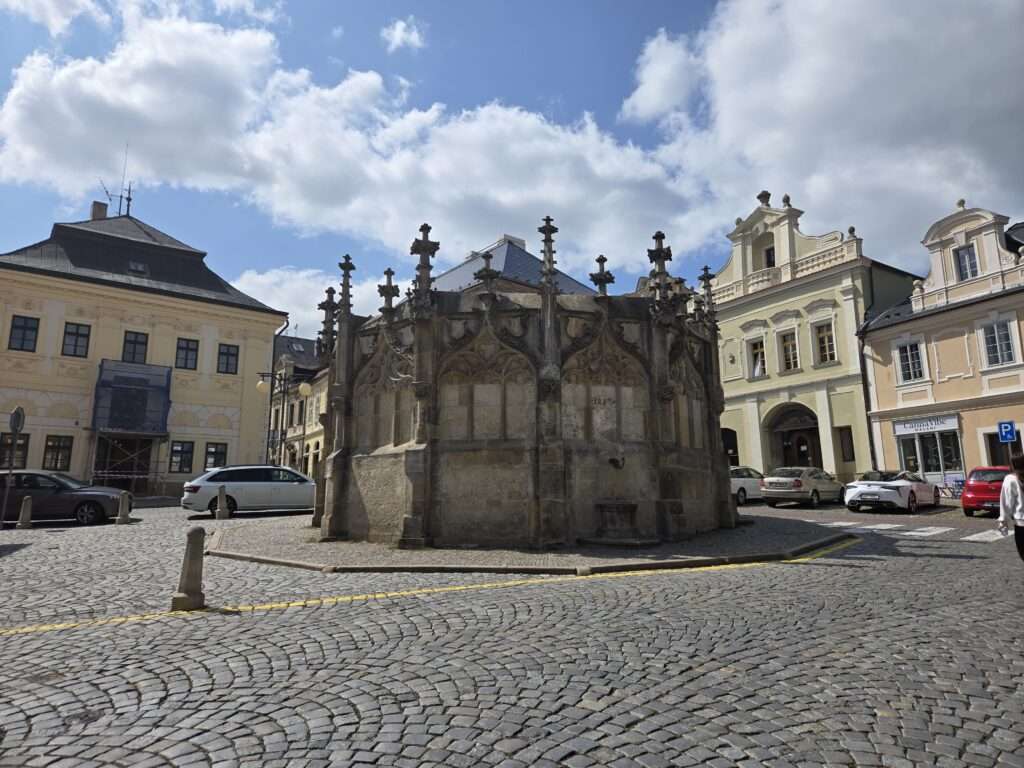
Photo above: This picturesque, polygonal fountain was built in 1496 by architect Matyáš Rejsek in Rejsek Square.
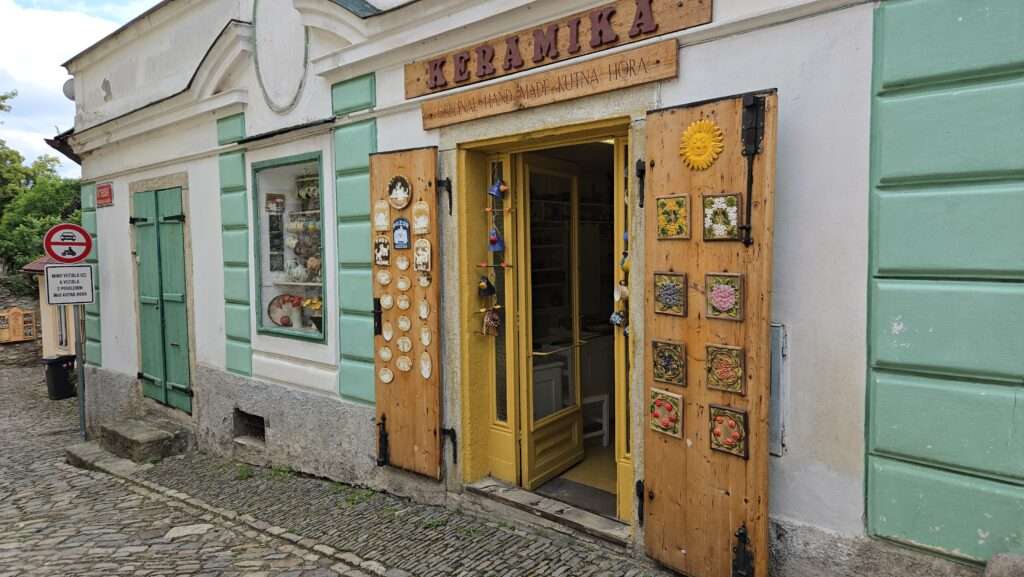
Photo above: If you like to shop when you travel, Kutna Hora has plenty of intriguing little shops you will want to pop into, and likely buy something to take home with you.
Church of our Lady Na Nameti
We did stumble upon one more church in the historic center that we hadn’t planned to visit, the Church of Our Lady “Na Náměti.” It just kind of rose up out of the neighborhood and we had to go see what it was.
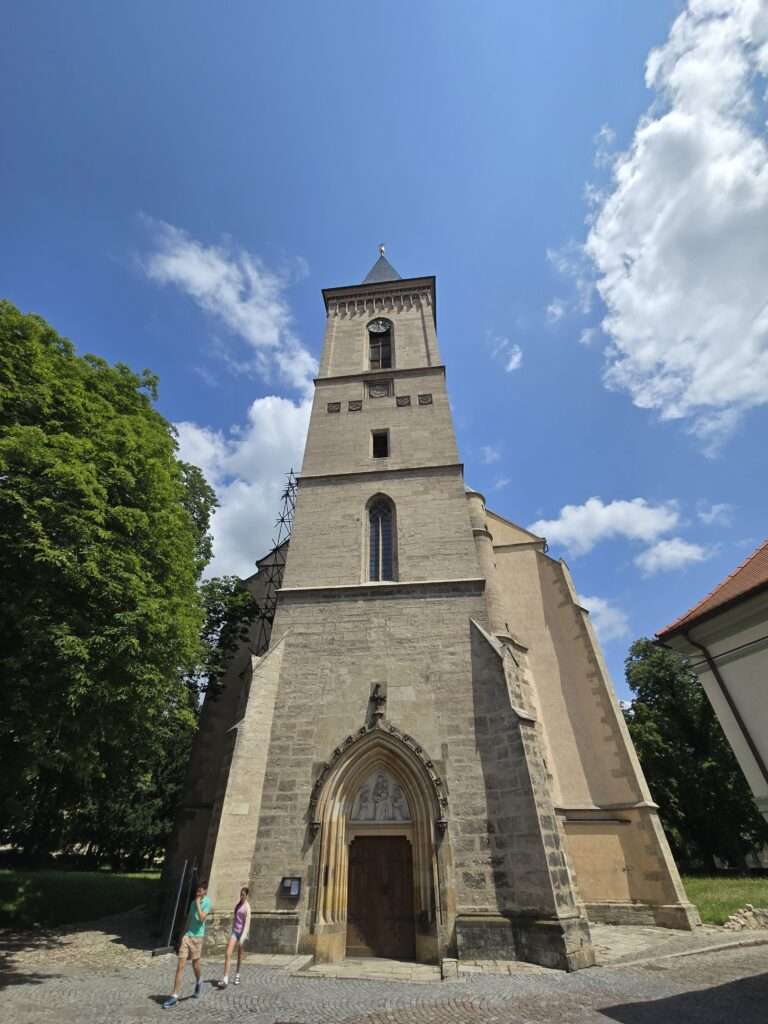
Finally, we made it to the Bone Church, the Sedlec Ossuary
It was the Bone Chapel that put Kutná Hora on the map for us. It sounded so unique—such a perfect complement to all the Gothic architecture in Prague. You’re not allowed to take photos inside, and while I had the itch to snap a few anyway, I followed the rules. So I can’t share my own photos; this is one place you have to see for yourself (or via other people’s photos on the web).
It’s a small chapel and can be quite crowded—especially if you count the 40,000-plus people whose skeletal remains are on display. It’s dark and cold inside, like you might expect in a crypt. The chapel consists of a single space where you can circle the center and take in altars and décor made from human skulls and bones, ceramic snakes intertwined, and other religious relics. Some areas are better maintained or restored than others. There’s even a large chandelier fashioned from skulls and bones.
I’m not sure what exactly I was expecting. I think I went out of curiosity. And I’m not sure I really liked it. It might have been a little too morbid for my taste. I can’t quite explain why—it just felt strange to gawk at tens of thousands of nameless dead, many of whom died of the plague. For me, it was more disturbing than peaceful, and I’ll keep reflecting on why. It was still worth the visit; maybe the fact that it unsettled me made it even more important to see. My kids had mixed feelings too—some of my girls felt uncomfortable—but they were still glad we went.
It’s also fascinating why there were so many bones here in the first place. A Cistercian abbot brought a jar of earth from the site of Jesus’s crucifixion and scattered it over the cemetery, making this a coveted place to be buried. Then the plague brought many deaths and overfilled the cemetery, creating the need for an ossuary. The ornate arrangements didn’t come until the late 19th century—long after these people died. They had clamored to be buried in “holy” soil, yet they ended up above ground as art installations.
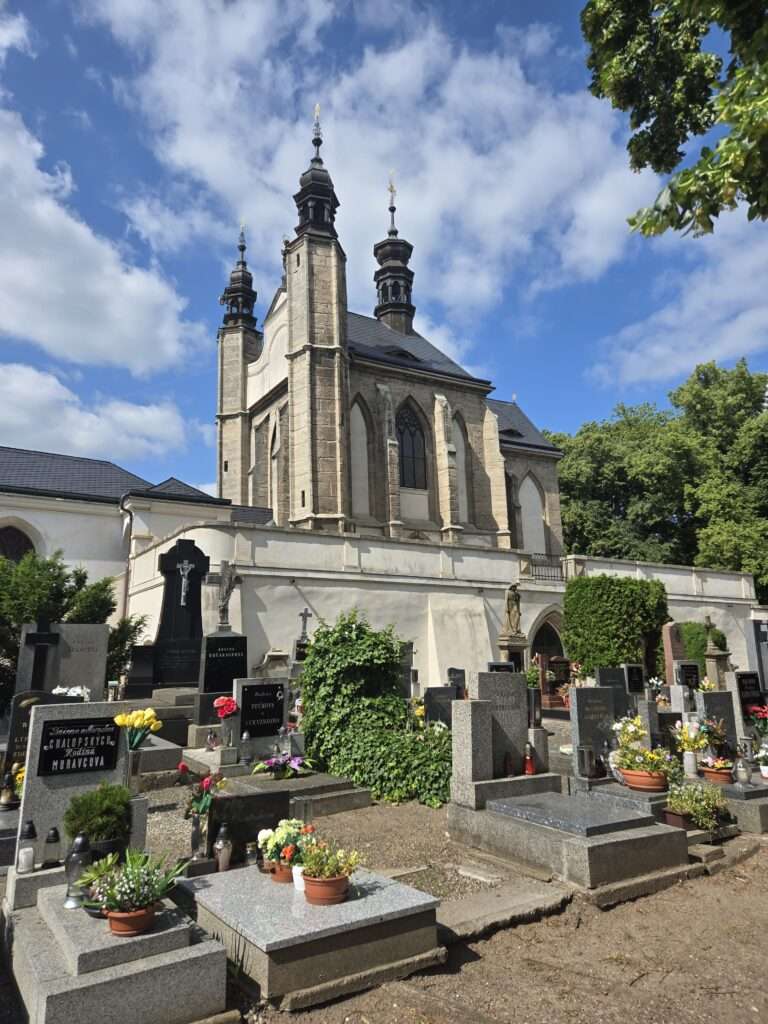
Photo above: The Bone Church in the center of the cemetery. Now the cemetery around it, felt particularly peaceful to me, after exiting the ossuary.
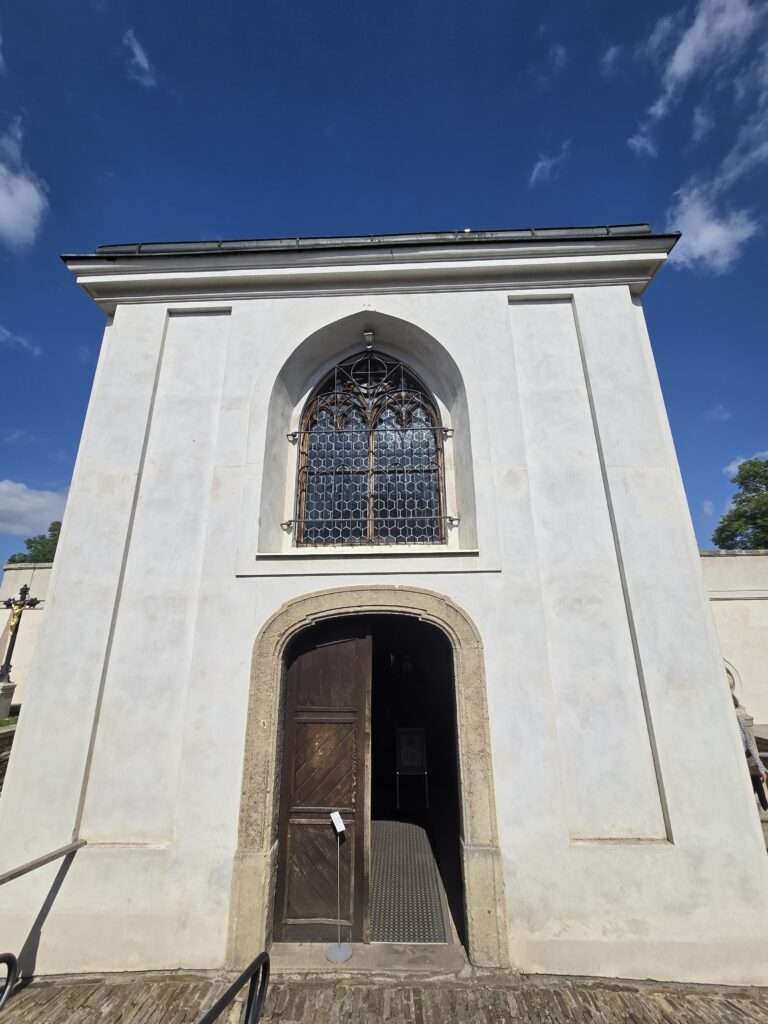
Photo above: The unassuming entryway into the Bone Church. You’d have no idea from this view, of what awaits you inside.
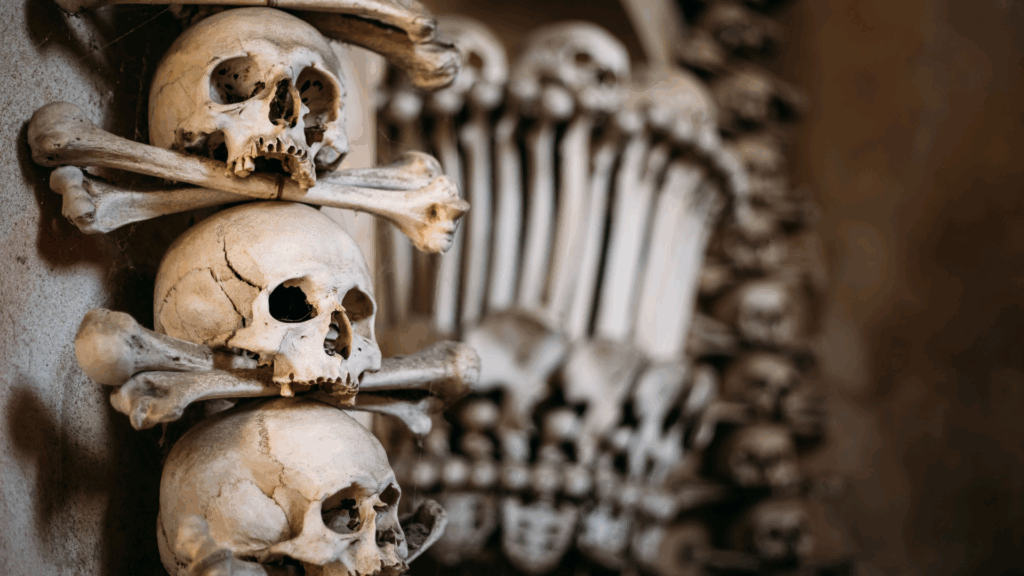
Photo above: Stock image of what you can expect to see inside. But for better photos, see the Sedlec Ossuary’s official website.
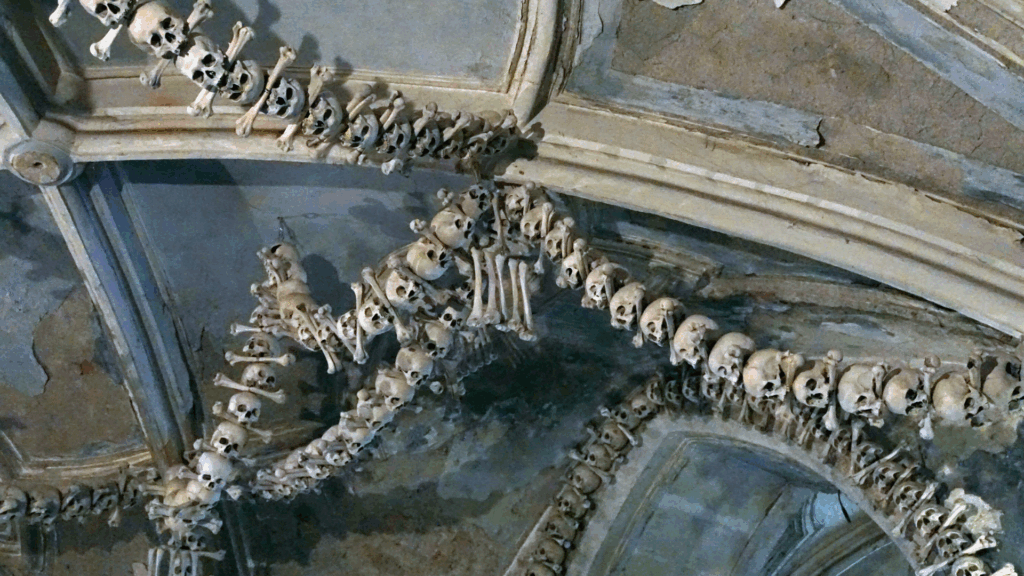
Photo above: Another stick image that gives you an idea of what to expect on the inside.
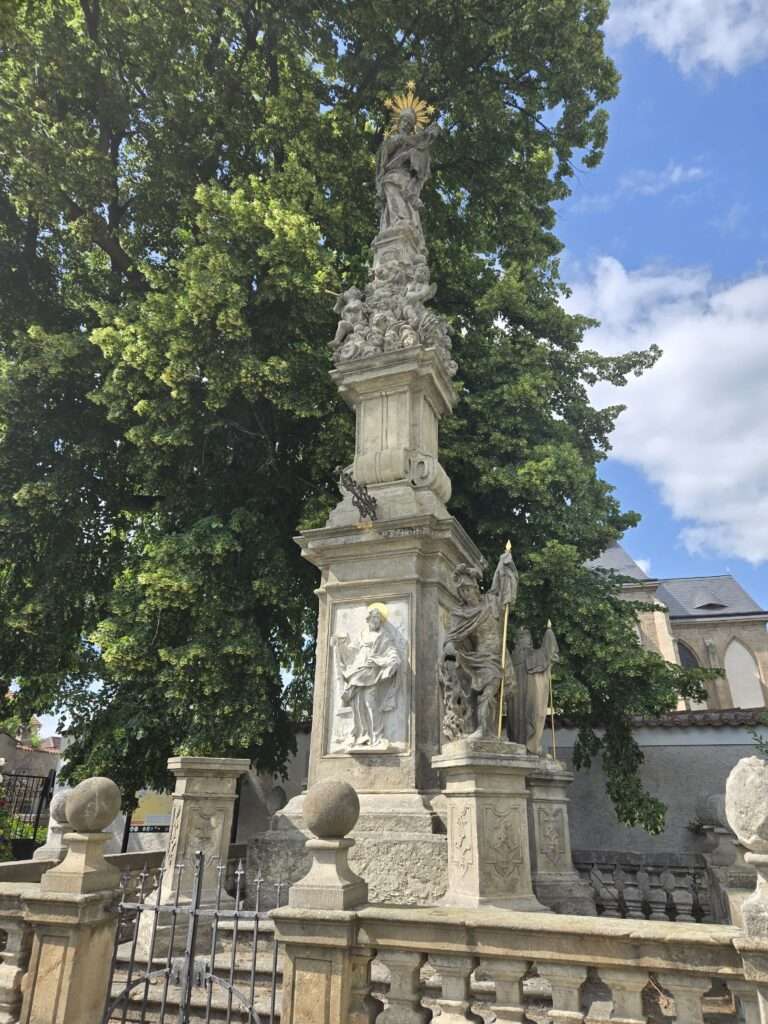
Photo above: Outside the Sedlec Ossuary and cemetery.
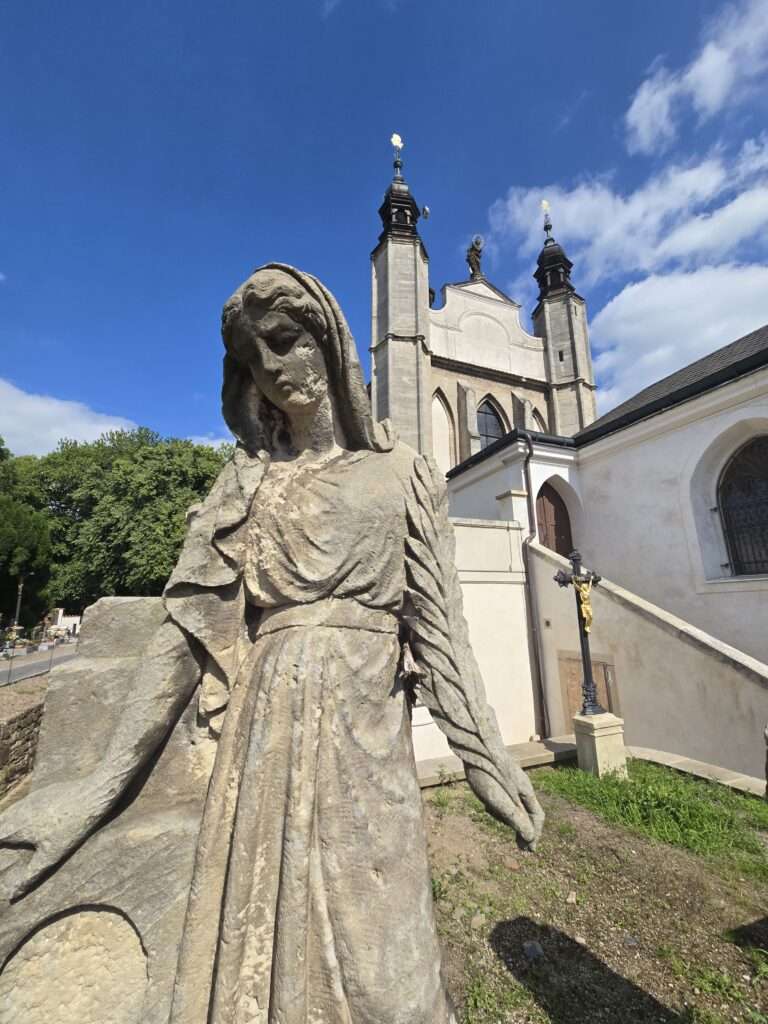
Photo above: Statue inside the cemetery.
The Lego Museum in Kutna Hora
There are a couple of special-interest stops nearby. For anyone not keen on the Sedlec Ossuary—or with kids who are too spooked—the Kutná Hora Lego Museum is a fun reprieve. You can’t miss it: you’re greeted by Kutná Hora’s very own Lego skeleton, so you still get a wink at the bone theme. The museum boasts 1,200+ unique Lego models, including builds of local landmarks, plus an inviting children’s play corner and a small museum shop.
The Philip Morris Tobacco Museum (adults only) isn’t far either. It offers free entry and sits at the modern factory. Visitors can learn about the company’s history and present-day operations and see a large collection of cigarette packages. We didn’t go in, but we passed it—it’s very close to the Sedlec train stop.
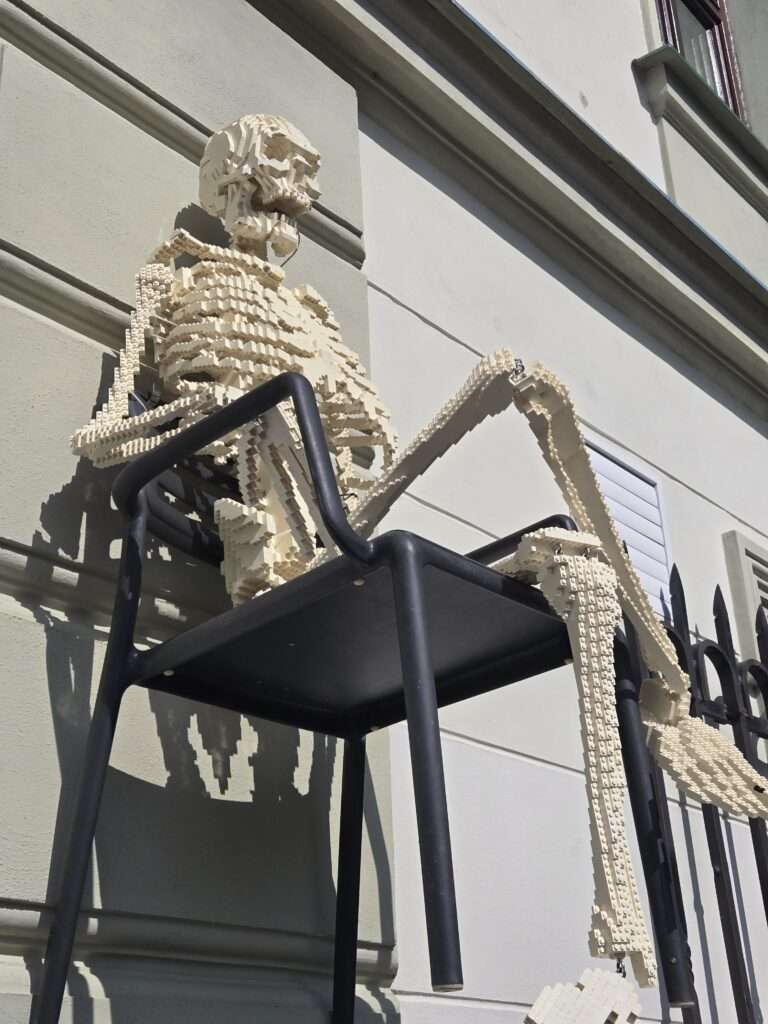
Photo above: This guy got our attention, as he watched us right back.
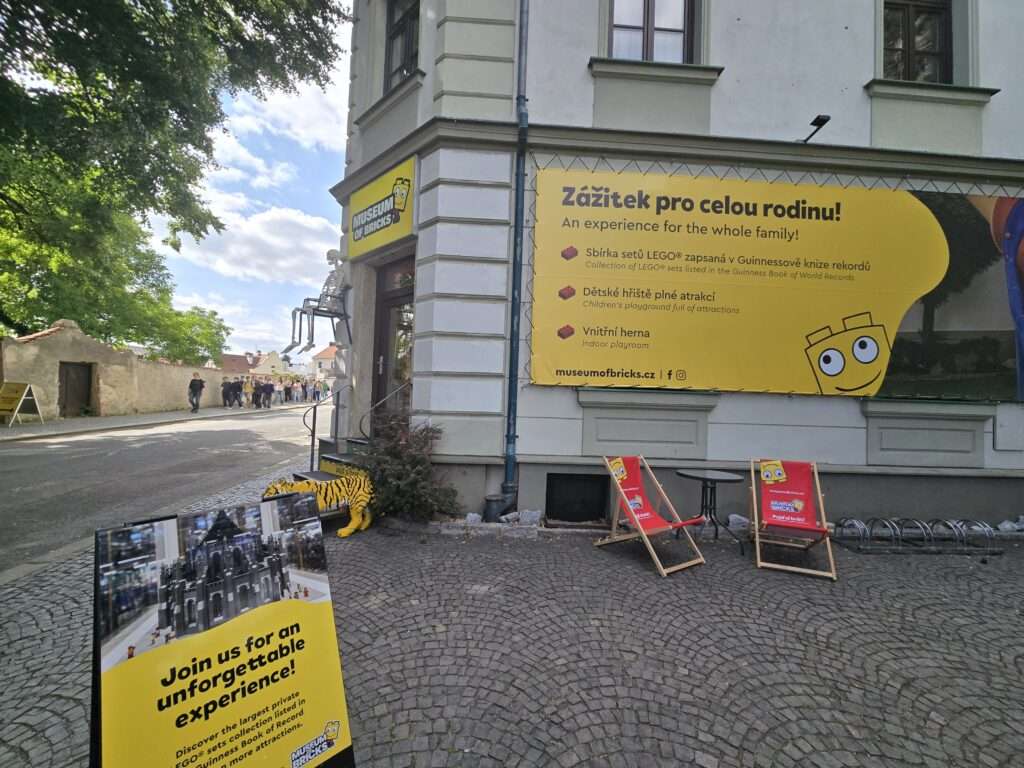
Photo above: The outside of the Lego Museum.
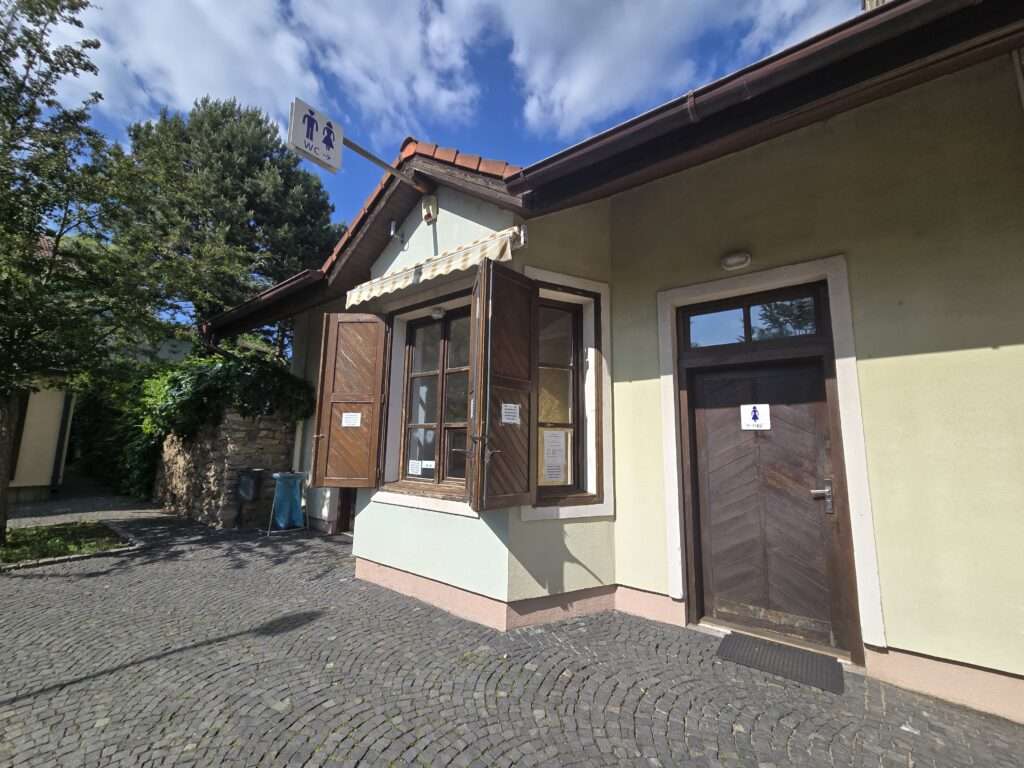
Photo above: Public restrooms bear the Lego Museum and the Bone Church (cash only).
Cathedral of the Assumption of Our Lady
Our final stop in Kutna Hora was the Cathedral of the Assumption of our Lady and St. John the Baptist. After everything else we’d seen that day, it felt a bit underwhelming by comparison. It’s probably better to start your day here than end it. Either way, it’s still worth a quick visit—with a treasure hunt for details. Its blend of Gothic and Baroque is unique and part of why it’s on the UNESCO World Heritage list. It also boasts a few accolades: it’s often cited as the longest church in the Czech Republic, it houses the oldest Gothic monstrance in the world, and it holds three original Petr Brandl paintings. You’ll be in good company too, given how many rich and powerful figures have passed through over the centuries. The site once included a monastery—those grounds now belong to the tobacco factory.
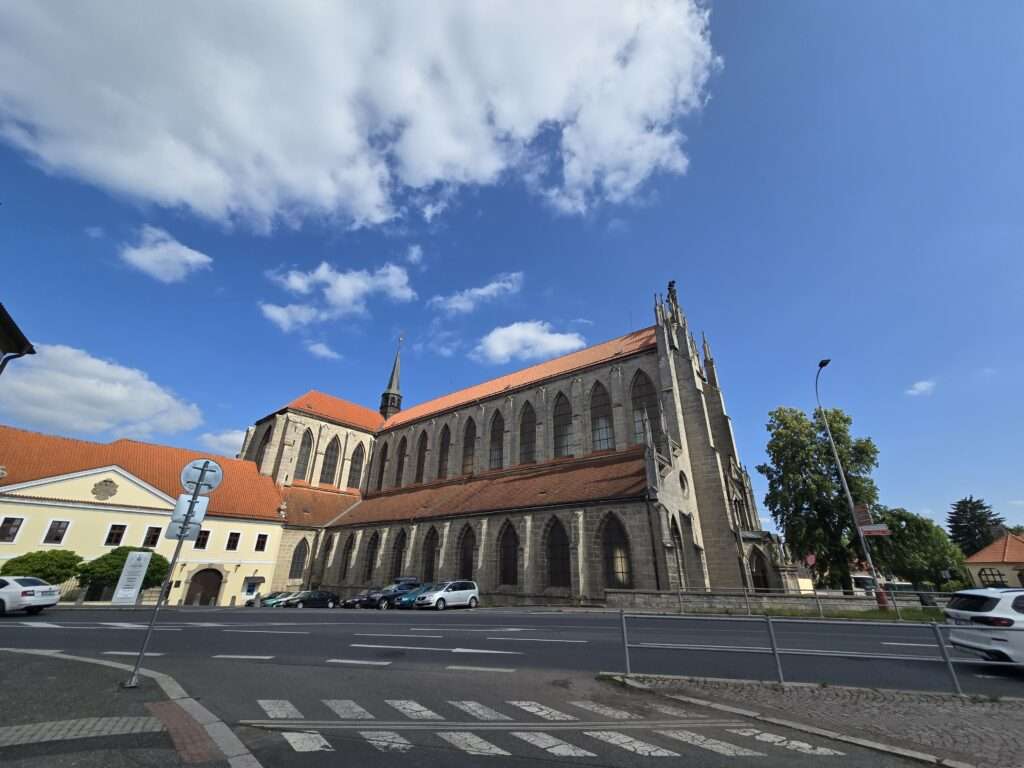
Photo above: The cathedral from the side, showing her length.
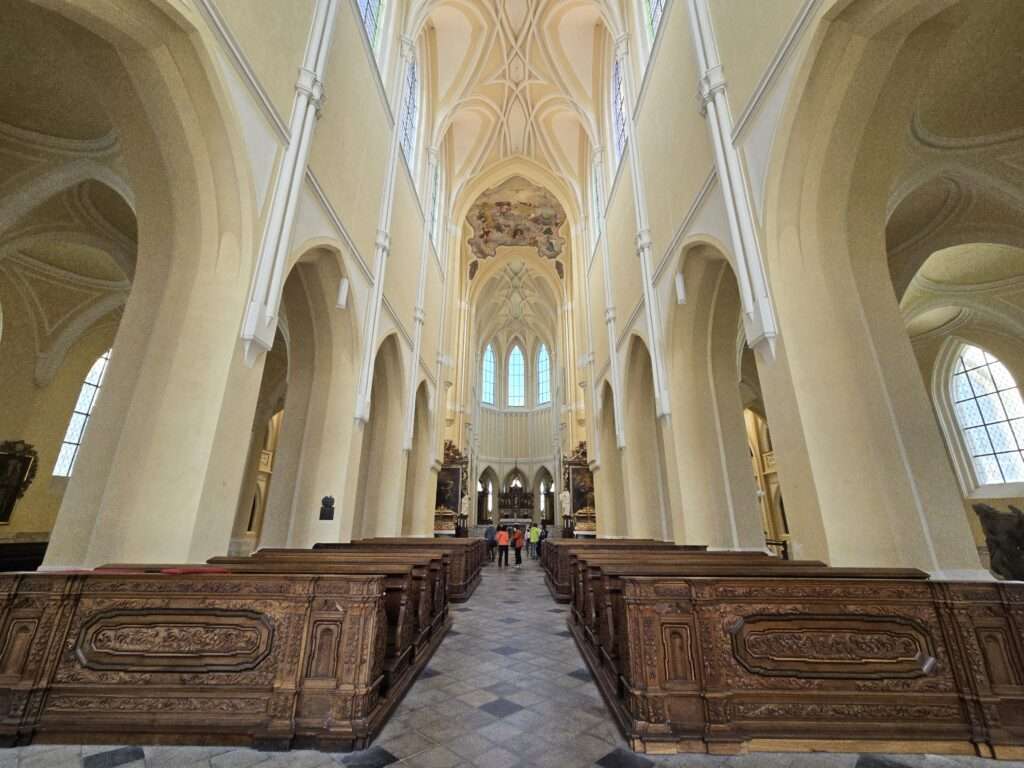
Photo above: The interior of the cathedral.
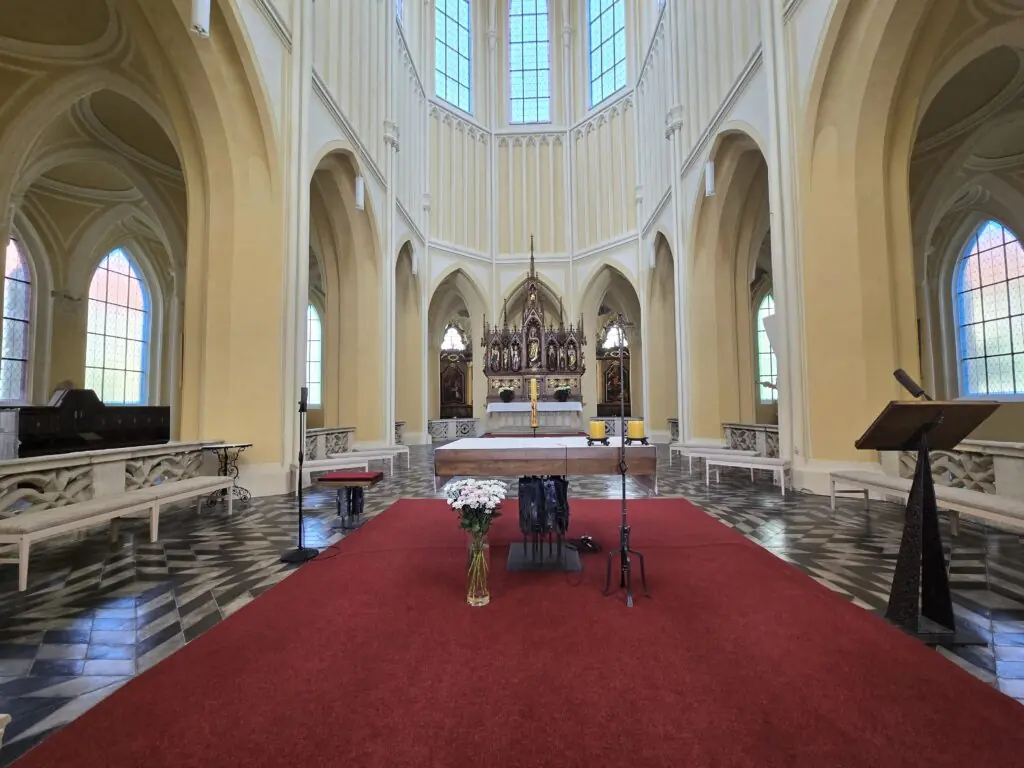
Photo above: Another interior view with relic and original floor.
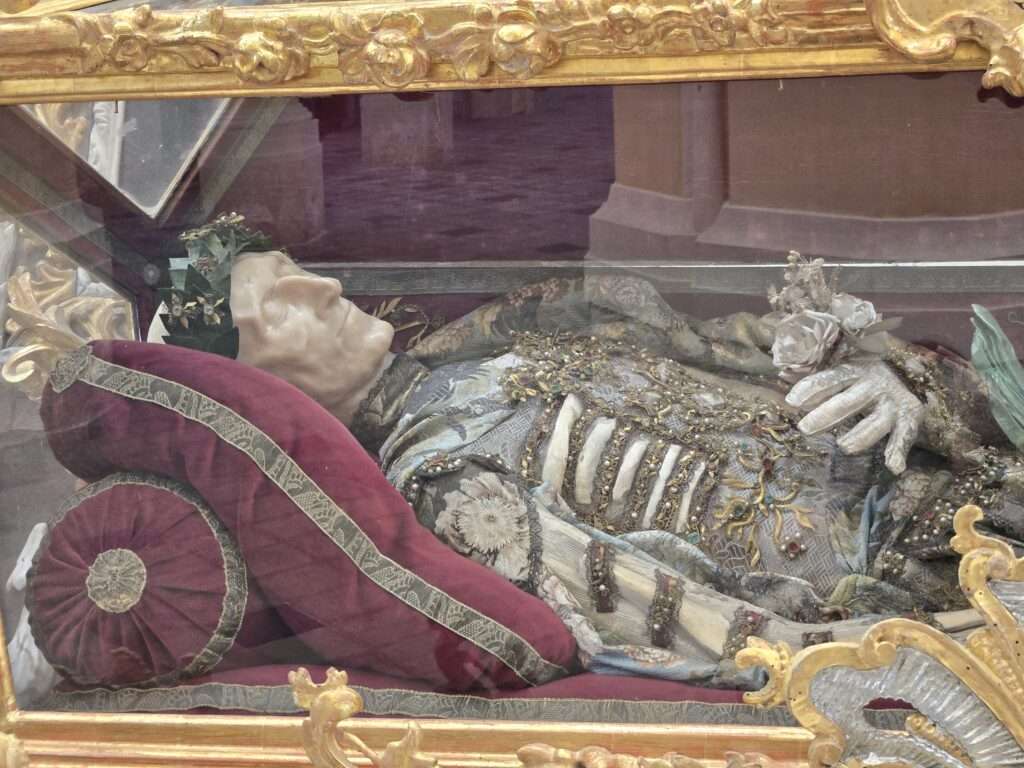
Photo above: There are two caskets on display, with skeletal remains protruding through clothing and the death mask visible.
Top Lists of Things to See in Kutna Hora
Now you know what we saw when we visited. We didn’t quite make it to see everything we had planned, and to be honest, you probably need more than a day if you want to see more than the essential sites. So, I’ve compiled a list for you to put together an itinerary that fits your timeframe and group:
The Essentials
Sedlec Ossuary (Bone Church) — inside the Cemetery Church of All Saints. Learn more
Cathedral of the Assumption of Our Lady & St. John the Baptist (Sedlec) — UNESCO-listed Cistercian monastery church. Learn more
St. Barbara’s Cathedral — late Gothic showpiece; official page (incl. roof-gallery guided tour), plus regional tourism profile. Learn more
Corpus Christi Chapel (Kaple Božího těla) — High-Gothic interior right by St. Barbara’s. Learn more
- Barborská Terrace — terrace is lined with thirteen 18th-century statues by František Baugut.
Italian Court (Vlašský dvůr) — former royal mint & palace. Learn more
Czech Museum of Silver – Hrádek & the Medieval Mine — museum + guided underground mine route (helmets/lamps, ~250 m of medieval gallery). Learn more
UNESCO historic town centre — overall inscription (covers St. Barbara’s & Sedlec sites). Learn more
Worth Your Time, If You Still Have Time
Jesuit College & Barborská Terrace (GASK gallery + statue-lined promenade) — Baroque Jesuit College houses the Gallery of the Central Bohemian Region; its terrace is lined with the 18th-century statues by František Baugut. Learn more
Stone House (Kamenný dům) — late-Gothic burgher house that’s part of the Czech Museum of Silver. Learn more
Stone Fountain (Kamenná kašna) — 15th-century, 12-sided Gothic water reservoir on Rejsek Square (great photo stop). Learn more
Church of St. James (sv. Jakub) — the landmark with the asymmetrical tower just off Barborská; listed by the city as a key sight. Learn more
- Dačický House (interactive UNESCO exhibition) — hands-on intro to why Kutná Hora is UNESCO-listed. Learn more
Lovely, A Bit Lesser Known and Worth Seeking Out
Ruthardská (Ruthardka) Lane — atmospheric medieval lane along the former town walls, linking Hrádek, St. James, and the Italian Court (official city write-up).
Church of St. John of Nepomuk (Husova St.) — town’s main Baroque church; listed among sights by the city and regional UNESCO portal. Learn more
Plague Column (Marian Column) — Baroque column by Baugut on Šultysova Street; background from GASK’s Jesuit College history. Learn more
Ursuline Convent & Church of the Most Sacred Heart — Dientzenhofer-era complex noted on the city’s official sights list. Learn more
Practical/quirky extras (if they fit your interests)
- Philip Morris exhibition (Sedlec) — adults-only historical exhibition at the factory perimeter, noted by the official city route guide (Sedlec→Kaňk walk). Learn more
- The Kutna Hora Lego Museum (Sedlec) — a lego museum with over 1200 models on display, inlcuding unique models of local sites. Learn more
- Museum of Kutna Hora Legends, Ghosts, and Haunts – become a part of the stories and legends of Kutna Hora. Learn more
Kutna Hora Day Trip Sight-Seeing Loop
Start at Sedlec
(Many Prague trains arrive at Kutná Hora hl.n. → hop the local train one stop to “Kutná Hora–Sedlec”; the same line later runs to “Kutná Hora město” by the old town. Pay attention, or you might miss your intended stop.)
Sedlec Ossuary (Bone Church) — 30–45 min
Walk ~3–5 min from the Sedlec stop. Buy tickets on-site (or at the Sedlec Info Centre). Check day-of hours.Cathedral of the Assumption of Our Lady & St. John the Baptist (Sedlec) — 25–35 min
~7–8 min walk from the Ossuary. You can visit the cathedral on a separate ticket if you prefer.
Transfer to the historic centre
From “Kutná Hora–Sedlec,” ride the local train a few minutes to “Kutná Hora město” (above the old town). Taxi/bus also fine if timing is better.
Stone House (Kamenný dům) — 10–15 min
Walk down toward the centre; Stone House belongs to the Czech Museum of Silver.Stone Fountain (Kamenná kašna) — 5–10 min
Quick photo stop at Rejsek Square.Church of St. James (sv. Jakub) — 10–15 min
Peek at the landmark with the asymmetrical tower.Ruthardská / Ruthardka Lane — 5–10 min
Atmospheric lane along the walls linking Hrádek and the Italian Court (spot of local legends).Italian Court (Vlašský dvůr) — 45–60 min (tour)
Former royal mint & palace; tours typically run regularly.
LUNCH (built-in stop): Restaurace Dačický — 60–75 min
Classic Czech kitchen a short walk from the Italian Court.
What to order: roast duck with red cabbage & dumplings, or wild-boar goulash.
Lighter/veg ideas: fried cheese (smažený sýr) with tartar, potato pancakes (bramboráky), seasonal soups.
Beer tip: ask for Kutná Hora lager on draft (house label).
Timing: Plan lunch right after the Italian Court, roughly 12:30–14:00 depending on your start. If the mine tour is time-fixed, eat before it.
Jesuit College Terrace (GASK) & statue promenade — 10–15 min
Stroll Barborská terrace with its row of saint statues.St. Barbara’s Cathedral — 30–45 min
Late-Gothic masterpiece; upper-gallery/roof options appear seasonally.Corpus Christi Chapel (Kaple Božího těla) — 10–15 min
Quiet High-Gothic interior a few steps from St. Barbara’s.Czech Museum of Silver – Hrádek & the Medieval Mine (Tour II) — 90–120 min
Guided underground route with helmet/lamps (~250 m). Book/queue accordingly; narrow sections.
Wrap / return
From the Hrádek / St. Barbara’s area, walk ~15–20 min up to “Kutná Hora město” for the local train to Kutná Hora hl.n. and onward to Prague. You’ll have put in a solid day, but will have covered all the key attractions.
Kutna Hora Kids Adventure
If you will be visiting Kutna Hora with kids, consider some of these kids activities to help them engage with their visit.
For example:
St. Barbara’s Cathedral
Stained Glass Window Stories
Mini-challenge: “Pick a window and tell the story you think it’s showing—who’s the hero, and what’s the quest?” With multiple kids, they could take turns telling each other the stories they see. Record one or two as a keepsake.
When leaving, share that the church took 500 years to build! What would they add to the church today if it was their job to complete it?
Statue Guardians – Jesuit College Terrace
Statues with Superpowers
Point out: the statues guarding the path with the views
Mini-challenge: “Pick a statue and invent its superpower. What does it protect?”
Add On: Can you find something with circles, lines or animals?
Now, Something For Older Kids
The Legend of Ruthard Lane
Kutná Hora has its share of ghost stories. One of the best known is the legend of Ruthard Lane (Ruthardka). The tale has been adapted into a play and even inspired the character Rosa Ruthard in the 2025 video game Kingdom Come: Deliverance II.
As the story goes, Ruthardka was home to a wealthy merchant named Ruthard, as rich as he was greedy. He refused to let his beautiful daughter Rozina marry—he didn’t want to part with a dowry—so he bricked her into the cellar where he kept his money. Passersby were said to hear her cries at night, and after her death Rozina’s ghost haunted the lane. In time the house was believed to be cursed; in 1648 it collapsed, burying everyone inside.
Parent note: Save this for older kids/teens. It’s atmospheric to tell while walking Ruthardka Lane—then ask: “What lesson is this legend trying to teach?”
